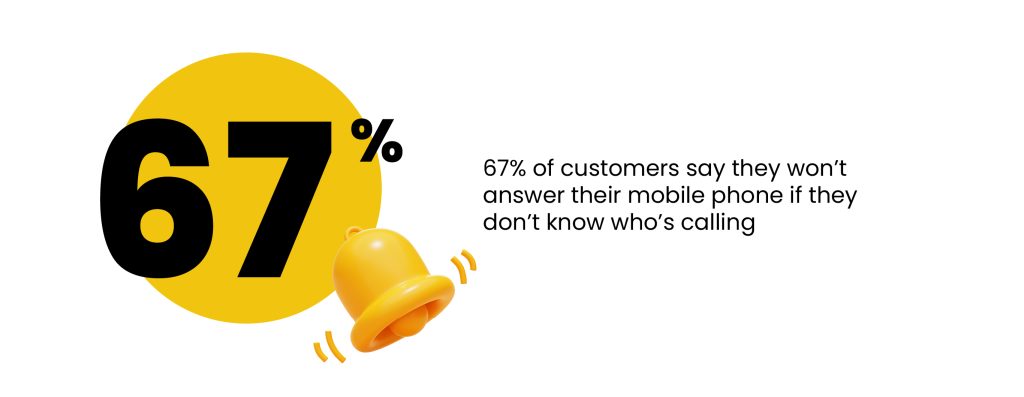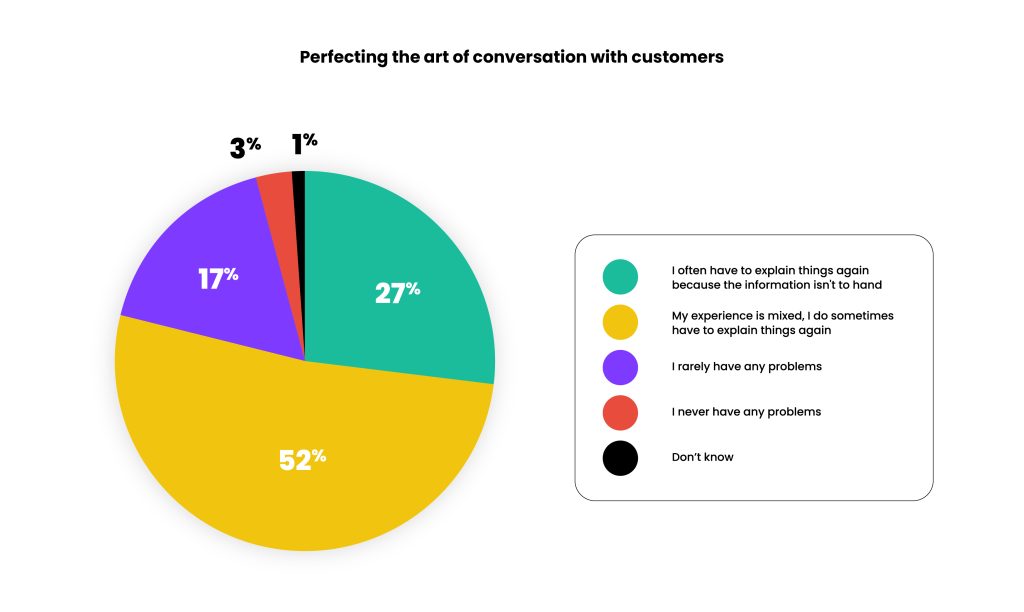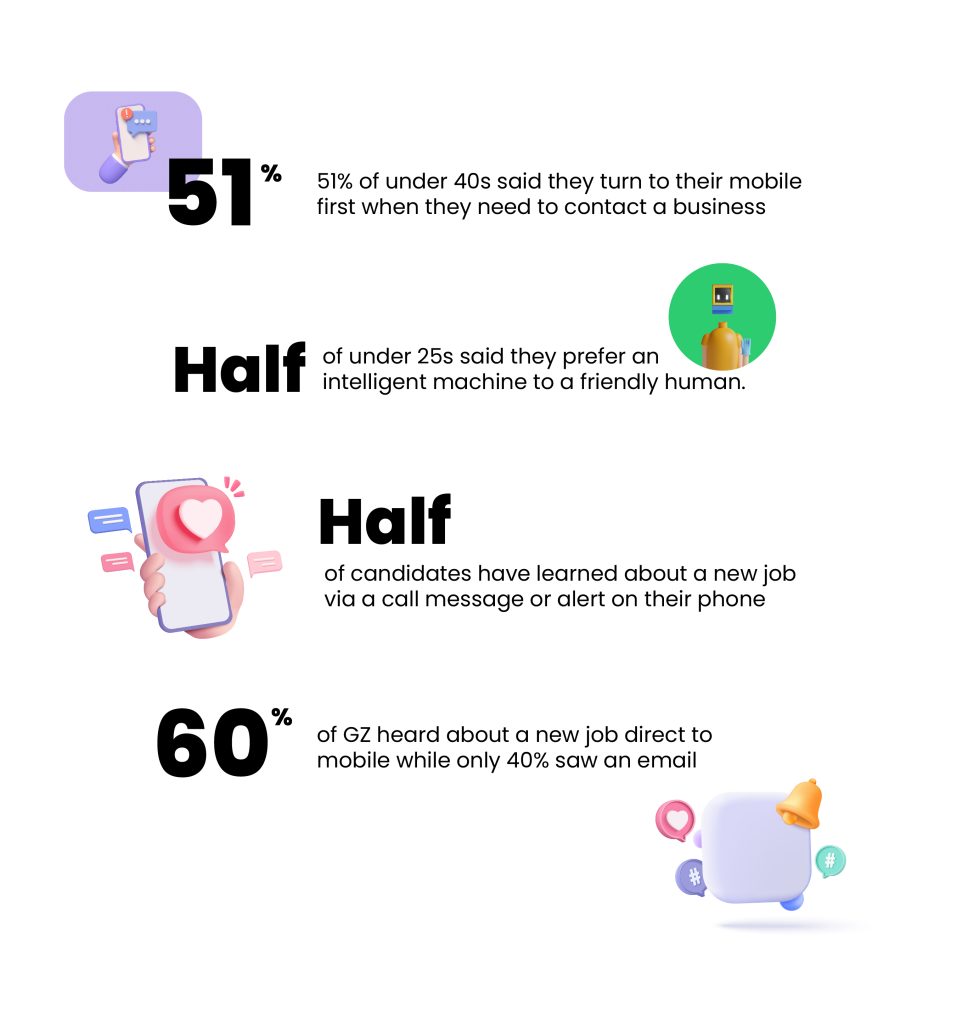Let’s talk about conversation.
Why?
Because as a seedbed for new ideas, making connections and building trust, conversation matters. How better to facilitate conversation than by using all the digital communication channels at our disposal today, then?
Well, yes, but there’s a catch.
Although digital transformation has accelerated our means of communicating, the revolution of technology has ironically forced us back to the drawing board on conversations, albeit with a new set of tools.
Conversations are changing
Remember when our 2020 conversations went something like this?
– I can’t wait until things go back to normal.
– Yeh, I miss the good old days.
As we know, there was no great comeback for the good old days. At the height of the pandemic, customers were wrestling for refunds, delivery slots and urgent medical appointments. Inevitable absenteeism and high call volumes put a squeeze on contact centres, leaving businesses under peak pressure. Some had to restrict calls while others had no choice but to close down.
But out of the chaos came some clarity. Three years on from the start of the pandemic, and time to adjust has created a new era of communication. Hybrid working and increased use of instant messaging, group chat and video conferencing platforms have turned conversation on its head. We’ve found newer, faster and easier ways to converse and work.
A new age of conversation challenges businesses to not simply adopt new channels, but to expertly manage an increasing number of them. According to the Contact Centre Research Programme, utilising multiple channels during economic uncertainty is more important than ever. As the cost-of-living crisis rumbles on and customers seek ongoing support, there is a new onus on businesses to arm their teams with a more advanced level of emotional and social literacy to assuage concerned callers.
And that’s not all.
The march of the AI revolution didn’t stop when the pandemic was over. Still in its infancy, AI already provides a more personalised customer service through integration with speech recognition and, aligning with the need for EQ-enabled teams, AI may also be used to gauge the emotional state of customers through sentiment analysis.
AI (at least for now) is an appendage to the arsenal of digital communication tools we have at our fingertips. But are we making the most of these tools to have the best conversations? And are we speaking to people in the right way and on the platforms they want? Has our disconnect from the fundamental art of conversation impacted our ability to converse as we need to?
We draw on customer research we commissioned in 2020, that surveyed over 1000 customers, and along with new insights, we look at the new world order of conversation, and how businesses can reclaim it.
The phones are still ringing
Despite the ubiquity of smartphones and instant access to emails, texts, and messaging apps, phone calls are still a thing. While automated chat software is becoming more readily used, as Call Centre Journal reports, voice telephony is still the strongest customer service tool. Our research backs this up, revealing that even before the pandemic, 69% of businesses said inbound call volumes had increased in their contact centres.

So, what is causing the growth in an ever-increasingly digital world?
While some businesses cite organic growth, others say it’s simply customer choice. We discovered that over half of businesses who saw a surge in inbound traffic believe it’s because customers prefer to talk to someone, and half say it’s the need for a fast response. According to Google’s Click to Call Research 59% of customers prefer to call because they want a quick answer, and 57% call to speak to a real person.
Why ring for a resolution?
Phone conversations are easy, direct and particularly powerful in urgent support situations. 45% of customers favour making a call to arrange or change an appointment or service call – that’s double the number who would rather self-serve via email or a website in those instances.
Phone calls are unrivalled in their capacity to personalise communications, so when it comes to gaining support on an issue with a delivery, for example, customers instinctively press ‘call’. Preference only changes to self-service channels when customers want to access system-based information such as an order status.
Outbound contact -the end of phone alone
Although cold calling’s reputation may precede it, outbound contact is still used widely for service calls and appointments. Around half of those we surveyed say it’s the channel most likely to get attention and has the best response rate. This perhaps explains why businesses still prioritise voice for arranging service calls and appointments.
But phones don’t do it alone. For sales calls and reminders, SMS and email lead the way. In fact, as the least costly means for large scale marketing campaigns, email dominates with 43% rating it as the lowest cost channel.

The art of improving phone conversations
Managing queue times
With the rise in phone call volumes, comes a rise in call queue times, placing pressure on call centre resources. The greater potential for dissatisfied customers gives rise to increased customer churn, with nearly half of customers stating they had bought elsewhere or cancelled a contract because they struggled to get in contact with a supplier.
Our research showed that managers are addressing queue times by:
- Increasing self-service and reducing agent intervention
- Offering virtual queuing
- Improving call handling for first-time resolutions
Just under three-quarters of businesses use automated answering technology in some form, and more than half use automatic call back features, reducing agent intervention and enabling call handlers to engage in more productive and less stressful conversations. Compellingly, call back technology is helping businesses gain and retain customers they may otherwise have lost.
Improving CRM integration
A key frustration for customers when making contact with a firm, is that their customer history is not available, yet 80% of the customers we spoke to experienced just that. With phone calls the channel of choice when things get complicated, and the growing complexity of customer journeys, CRM integration has the potential to improve phone conversations dramatically.
But businesses still have a way to go. Although most firms acknowledge the need for more seamless customer interactions with 52% appreciating that a lack of integration is limiting them, only 38% hold their data in a single CRM. Under a third of those with more distributed data had made a conscious decision to do so, while others were simply dealing with infrastructure acquired over time or inherited.
Combining phone with SMS
Still an effective tool in outbound sales, voice telephony does have its limitations, with 67% of customers preferring not to answer if they don’t know who is calling. This equates to big costs for businesses, especially when calls are related to new job opportunities or reminders of a pre-arranged call out.
Interestingly, service-led businesses, e.g., logistics and utilities, are more inclined to make customers feel valued with a personal message than their retail and e-commerce counterparts. They are also more likely to follow-up using an SMS with contact details or a link to a self-service area to help gain tangible results. Those who use SMS for reminders state that it has resulted in 19% fewer missed appointments or unsuccessful callouts.
And lets not forget about the phone call itself…
What businesses can do:
- Generate feedback in real-time by monitoring calls. With ‘monitoring’ capabilities, you can supervise a conversation without joining. Then, give feedback immediately after the call.
- Gauge the quality of customer interactions by recording every conversation (good or bad) and build a library of best practices for training new employees as well as interactions to avoid. With the right software, recording calls is easy and the entire team can reap the benefits.
- For outbound calling, consider using local presence dialling software. Local numbers help increase pick up rates by more than 200%.
What call agents can do:
- Remember conversations need purpose. Sharing this purpose when initiating a call allows all parties to walk away with clear actions.
- Actively listen while in conversation. Consciously pausing while the other person speaks, and refraining from interjecting communicates engagement to the other caller.
- Maintain good posture, to help you speak confidently and with conviction. Your voice projects more clearly and signals a sense of authority that is often helpful when handling challenging calls.
- Be genuine and respectful to make your customers feel valued.
- Speak clearly so your customers can understand you. For improved response rates on outbound calling, text or email before calling. This shows the call is legitimate and can improve response rates.
- Have a top performer supercharge a teammate’s conversation by ‘whispering’ advice during a call without being heard by the other person.
- At the end of the call, summarise your understanding of the conversation. This lets the caller know you have listened and it can also help diffuse things if a customer isn’t happy.
While phone calls overshadow other channels for responding to more complex customer queries, providing reassurance and accelerating sales, their overall success, to a large degree, relies on an omni-channel approach. Demonstrating the point, headhunting platform Source Whale, reports that 66% of its new business meetings booked in April 2023 came as a result of phone calling, but when calls were used in isolation with no other channels, the success rate was significantly lower.
So, is this what we mean by an omni-channel approach? Or is there more to it?
Navigating the omni-channel highway
An omni-channel approach is not just about combining SMS with phone calls, it’s about creating a seamless customer experience across a range of different channels. But with so many to choose from, conversations are becoming fragmented. We know that phone calls offer quick and simple ways to provide effective customer service but what do other channels offer that voice telephony cannot?

Know your channel choices
SMS
Texting has become such an integral part of our modern lives it’s hard to believe the first texting phone was created 30 years ago (special mention to Nokia). No longer frowned upon when used in the workplace, the prevalence of mobile phones has prompted businesses to use them to their advantage.
It takes the average person 90 seconds to reply to a text, and 95% sent from businesses are typically read within 3 minutes of being sent (Forbes). These impressive response times means businesses are already using texting to start conversations, gather feedback, promote time-sensitive offers and run marketing campaigns.
Here are some pointers before hitting ‘send’ on your next SMS
- Keep messages brief (around 140 characters). If there’s lots to say, an email or phone call may be better
- Check spelling and errors before sending because when it’s gone, yep, it’s gone.
- Use polite language to avoid coming across as abrupt
- Don’t keep sending messages if you don’t get a reply, it may seem intrusive or rude
- Always respond promptly when you get a reply and let people know when you’re signing off from texting
- Remember, not everyone likes, understands or appreciates abbreviations or emojis, they may be too informal
- Check that your text is timed well
- Try using message templates for multiple texts to keep things consistent
- Tailor your texts to your target audience.
Tip: Ensure SMS messages are stored as searchable conversations, to save teams time sorting through individual notes. Access to a full conversation is crucial to understanding relationships. You might need to search your past conversations to gain context on an issue, or monitor conversation trends around certain topics.
Email is one of the most used communication channels there is. Influential in both B2B and B2C, emails give senders time to craft a message that hits all the right notes. Cost-effective and direct, they can be sent to recipients on a global scale. Metrics such as open rates and click throughs are simple to retrieve and provide valuable insights. That said, the written word can come with some ambiguity, sometimes leading to misinterpretations. Emails that are too long, too frequent and lacking the personal touch, can be detrimental to conversations.
IM
Instant Messaging lends itself well to the natural flow and spontaneity of a good conversation. IM is rising in popularity too with 43% of employees using IM tools in the workplace. Audio messages allow for intonation and inflection and emojis bring a level of depth to a typed message. But with an eye-popping 70% of people admitting they have misunderstood a message; miscommunication happens a lot. Another snag with IM is the pressure to respond, and according to online poll by ReportLinker 57% of respondents said they was no guarantee work chats would remain private.
Social media
With 4.72 billion active social media users worldwide, social media is a huge force. As the largest platform in the world, Facebook has amassed over 2.9 billion monthly active users, and with 2 billion users globally, around 100 billion messages are sent every day on WhatsApp. Facebook Messenger is one of the most popular messenger apps for social media conversation with 931 million monthly active users in 2023. Social platforms allow businesses to build online communities, create their own customer service channel, and use social listening to monitor conversations on their brand.
Video conferencing
We are all video chatting more, in business and across the generation divide with one quarter of Millennials chatting every day. The mighty ‘Zoom meeting’ has become a standard term in business vocabulary and all-in-one communication platform, Microsoft Teams hit more than 280 million monthly active users in FY23.
In a business context, video calls are set up at the drop of a hat. They help improve productivity, reduce travel costs, and support a growing number of remote workers. As instant communication becomes expected, it’s a platform set to grow. Despite its advantages, video conferencing can be impaired with technical difficulties, detracting from the experience, so it’s imperative that it is used in the right way.
Remember, integration is everything
With so many channels, we are constantly entering and existing conversations, making context easy to lose. Customers may start a conversation online, and follow up using a different channel. 86% of customers say in those cases, it’s important there’s a record of their previous conversation. But all too often, that information isn’t available. Agents struggle to troubleshoot, and conversations break down if businesses don’t know if the person on the end of the phone has already been emailed, spoken to by another colleague, or sent an inquiry via self-service. Again, this is where CRM is critical to success, enabling a rich and connected digital omni-channel experience with all communication tools and customer data in one place.
Dial in to what customers want
On a fundamental level, navigating omni-channel requires a concerted effort from businesses to listen to their customers’ experiences.
Brace yourself, here’s a few unsavoury facts:
- 4 out of 5 customers regularly have problems getting in touch
- 38% report that their experiences are mixed at best
- 37% say poor contact is the norm
- Almost half of customers reveal they talk about their complaints to others,
- One fifth make negative comments on social media
With reputation stakes high, businesses need to tune into how customers want to interact, and learn more about what they are trying to do when they make contact.
Understand that channel preference is nuanced
All customers are different. While most prefer the phone when more support is needed, some customers still opt for digital channels, with 71% stating it’s important they can text or use other options if they don’t want to talk on the phone.
61% of respondents believe email has the advantage when ensuring conversations are ‘on record’ and it suits people who like to consider what they are going to say. There is concern with email response rate though, with over a third of customers following up and email using another channel before getting a reply, and 43% not emailing because they don’t know if they’ll get a reply.

Direct to mobile for Gen Z
From a generation stance, Gen Z is a slightly different animal, especially when it comes to outbound contact. A 2022 media use report from Ofcom revealed a growing number of internet users were accessing the internet exclusively via a smartphone, especially those aged between 25 – 34. Adding to this, our own research found that 76% of under 40s want to do ‘everything’ from their smartphone, and a large portion of Millennials and Gen Z are happy to go online to browse or buy from retailers in response to a call or mobile message.
But although Gen Z are more open to direct communication, and more likely to respond to tailored offers, they are also more attuned to the value of their personal data, and as a result, have higher expectations around personalised communications.

The future is mobile
Younger customers also have more confidence in automated systems, with 54% believing automated technology can work better than humans, and 50% preferring to deal with a computer than a person if it had full access to account details and preferences, compared with 39% of millennials.
With most of Gen Z expecting that in five years’ time we’ll talk to automated systems as if they were human, change is clearly on the horizon. This makes it imperative for businesses to develop their use of mobile communication and allow customers to talk without talking, and feel confident they’ll get a reply.
But does a new, more automated approach to customer communication in the future take us one step back from the traditional art of conversation, and does it matter?
Fine-tuning social skills to improve conversations
As well as planning for a more automated future, businesses still need teams with good conversation skills. According to a report by Holmes, businesses whose leaders possess effective communication skills produced a 47 percent higher return to shareholders over a five-year period.
The decline in face-to-face conversations
While technology makes it easier to communicate anywhere and at any time, it has also helped us to avoid direct conversations, causing a deterioration in our ability to initiate and hold a conversation and hindering professional productivity.
What we gain from face-to-face communication
Rapport – when it comes to building rapport with someone, nothing beats having an in-person face-to-face conversation. Whether it’s networking, meeting a new customer, going on a date or visiting a family member, all these situations require face-to-face contact for them to be positive experiences.
Non-verbal communication – only a small proportion choose to speak face-to-face, yet over 60% of us find body language key to how we interpret a conversation. Reading body language helps to gauge the tone of a conversation and understand the mood of others.
Clear messages – having conversations face-to-face reduces the possibility of misunderstandings and encourages more open and effective communication in both work and business.
Barriers to good conversations
Being good at any type of conversation is an art form that takes skills and experience to master. But what barriers stand in the way of a good conversation?
Failing to actively listen is a top conversation killer. It’s easy to formulate a response while the other person is talking but this can cause you to miss the point. A conscious pause before sharing your thoughts helps keep the conversation balanced.
Not asking questions can lead to unsuccessful communication. Asking questions allows you to reflect on what has been asked of you and ensures everyone is on the same page.
No rapport – when there’s no rapport with your conversation partner, you may find it awkward or unpleasant. Building rapport is as simple as asking how someone’s day has been or how they feel about current affairs. It’s always good for people to feel that they are speaking to someone friendly and willing to help.
Not understanding what you’re talking about. If you don’t know anything about the topic or person, you are going to struggle, especially in a business context. Have the right information at your fingertips, so you are fully prepared for the conversation.
Not being assertive. Assertiveness is an honest expression of needs, wants and feelings. Being too passive or too aggressive can sabotage a good conversation. Get the balance of being respectful, and non-judgemental to help you relate to others more genuinely.
Myths on assertiveness
Assertiveness is an important social skill to work on. It can be difficult to learn, especially since being assertive can mean holding yourself back from the way you would normally do things. For example, you may be afraid of conflict, always go along with the crowd, and avoid offering your opinions. As a result, you may have developed a passive communication style. Alternatively, you may aim to control and dominate others and have developed an aggressive communication style.
Here’s some common myths:
Assertiveness means simply getting your own way
No, being assertive means expressing your point of view and communicating honestly with others. Often, you may not get “your own way” when you are assertively giving your opinion. But telling others how you feel and trying to work out a compromise shows respect for both yourself and others.
Assertiveness means being selfish
Just because you express your opinions and your preferences does not mean that other people are forced to go along with you. If you express yourself assertively (not aggressively) then you make room for others. You can also be assertive on behalf of someone else (e.g., I would like Susan to choose the restaurant this week).
Passivity is the way to be loved
Nope! Being passive means always agreeing with others, always allowing them to get their own way, giving into their wishes, and making no demands or requests of your own. Behaving this way is no guarantee that others will like or admire you. In fact, they may perceive you as dull and feel frustrated that they can’t really get to know you.
It’s impolite to disagree
This is not true! Although there are some situations where we don’t give our honest opinion (e.g., most people say how beautiful a friend looks in her wedding dress, or we only say positive things on the first day of a new job). Much of the time, however, other people will be interested in what you think. Think how you would feel if everyone always agreed with you.
I have to do everything I am asked to do
False. A central part of being assertive is setting and keeping personal boundaries. This is difficult for many people. With our friends, we may worry that they will think we are selfish and uncaring if we don’t do everything they ask. At work, we may worry that others will think we are lazy or inefficient if we don’t do everything we are asked.
Improving conversations at work
Conversations at work are a vital part of the growth puzzle. How productively your business runs, relies on how well your teams can communicate and collaborate with each other, and their clients. Essentially, the way you communicate with your team influences the way your team communicates with customers.
Benefits of good communication in the workplace:
- Individuals are often more willing to commit to an organisation if they can communicate on all levels.
- When employees feel heard and respected through good communication, team performance often improves.
- There’s more opportunity for creativity and strategic initiatives when teams are given space to express themselves, this helps cultivate talents and skills that may otherwise go unnoticed.
- Freedom of expression also enhances relationships between employees and managers, which can only be a good thing.
We’ve already touched on the importance of positive body language and active listening in communication, but how else can you improve your workplace communication?
Don’t give out unsolicited advice
People may get defensive when told what they can and can’t do. Try to facilitate and encourage colleagues coming up with their own solutions. For example, asking thought provoking, open questions or providing valuable information that will help them to progress.
Tell a Story
Us humans, appreciate narratives centred on a strong character. Bring this to life next time someone comes to you with an issue by telling an anecdote about how someone resolved a similar situation. Your colleague can interpret this how they want, and they are more likely to remember a story than other forms of information.
Avoid Controversial Jokes
Humour is incredibly subjective. So, be careful about making jokes that may be perceived as insensitive. Remember, not everyone has the same sense of humour and you definitely don’t want to cause offence at work for the sake of a few laughs.
Encourage respect
Encourage respect in the workplace to reduce stress and risk of conflict before it arises. Increased mutual respect will improve overall communication. Accepting others even when they’re different is an important show of respect and allows team members to feel safe. Lead by example by developing clear rules for conduct and show your appreciation when your team exceeds expectations.
Keep work talk to a minimum
Even though you work in the same office, or industry, try to keep casual office conversations away from work related topics. Instead, talk to your colleagues or clients about more personal topics, such as current affairs or shared interests. This will help to build trust and form a great foundation for deeper, more in-depth conversations.
Apply the 7Cs of communication
The 7Cs of communication are a useful guide to ensure you are maximising communication efforts, the include:
- Completeness: Understand your audience’s mind-set and convey your message using all relevant facts.
- Conciseness: Communicate your message to your audience in as few words as possible.
- Consideration: Step into your audience’s needs and emotions. Empathise with them and demonstrate you are interested in what they feel.
- Clarity: Make sure that you communicate one message at a time. Don’t muddy the waters by sending out multiple messages on different channels.
- Concreteness: Support your message with clear facts and don’t blur the lines to avoid misinterpretation of your message.
- Courtesy: Be positive, sincere and focus on your audience. A courteous message never shows any bias.
- Correctness: Ensure there are no typing or grammatical errors in your message. Correctness boosts the confidence levels in the audience.
In summary
So, we’ve talked a lot.
But the conversation is far from over. While the phones are still ringing, and texts and emails continue to ping, further shifts in how we converse are on their way as new generations set the pace. Businesses need to know how to combine the fundamental art of conversation with multiple channels and new customer preferences, and they must equip teams with essential communication skills to increase productivity now and in the future.
Start the conversation rolling with a CloudCall expert today, and discover how our innovative CRM integrations can optimise your current communications.




